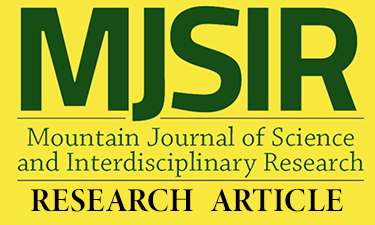Reflections and Learning A Case Study on Students' Community Health Nursing Immersion
Main Article Content
Abstract
Recognizing varied and real life community learning experiences of students are necessary as they are continuously deployed by the College of Nursing of Benguet State University for immersion to different placements. A case study was used as the research approach for this endeavor. Fifty-two reflective journals were reviewed and twenty-two student nurses participated in the study. Participant reflective journal reviews, observations, and focus group discussions were used as data collection methods. Using thematic analysis, four themes emerged from the students’ descriptions of their learning experiences: (1) unforgettable experiences: being with people; (2) facing challenges; (3) contributions to self and to the community; and (4) impacts on their lives. Real community health experiences of students should be treasured in nursing education. These can help identify better strategies in improving community learning experiences. This study; thus, hopes to provide further evidence-based indications for policy development to guide support networks working with and for grassroots community stakeholders.
Article Details
References
for nursing students compared to multiple
placements. Journal of Nursing Education, 41
(2): 80- 82.
Ajiboye, P. (2000). Learning partners. Nursing
Standard, 14 (52): 34.
Baglin, M., & Rugg, S. (2010). Student nurses’
experiences of community-based practice
placement learning: A qualitative exploration.
Nurse Education in Practice, 10(3), 144-152.
doi:10.1016/j.nepr.2009.05.008
Chan, D. (2002). Development of the clinical
learning environment inventory: Using the
theoretical framework of learning environment
studies to assess nursing students’ perceptions of
the hospital as a learning environment. Journal
of Nursing Education, 41(02), 69-75.
Cheek, J., & Jones, J. (2003). What nurses say
they do and need: Implications for the educational
preparation of nurses. Nurse Education Today,
23 (1), 40-50. doi:10.1016/s0260-6917(02)00163-
6
Clare, J., White, J., Edwards, H., & Van Loon, A.
(2002). Curriculum, clinical education,
recruitment, transition and retention in nursing.
Adelaide: School of Nursing and Midwifery, Flinders
University.
Creswell, J. W. (2009). Research design qualitative,
quantitative and mixed methods approaches.
Thousand Oaks: Sage.
Conway J. & McMillan, M. A. (2000). Maximizing
learning opportunities and preparing for
professional practice. In: J. Daly, S. Speedy & D.
Jackson (eds) Contexts of Nursing: An
Introduction. MacLennan and Petty, Sydney.
Dalton, A., Ahmed, I., & Sawan, J. E. (2011).
To 52nd Annual Adult Education Research
Conference and the 30th National Conference
of the Canadian Association for the Study of Adult
Education (pp. 155-162). Toronto, ON, Canada:
New Prairie Press. doi:http://newprairiepress.
org/cgi/viewcontent.cgi?article=3148&context=
aercthe
Dornan, T., & Bundy, C. (2004). What can experience
add to early medical education? Consensus
survey. Bmj, 329(7470), 834. doi:10.1136/bmj.
329.7470.834
Edwards, H., Smith, S., Courtney, M., Finlayson, K.,
& Chapman, H. (2004). The impact of clinical
placement location on nursing students’
competence and preparedness for practice.
Nurse Education Today, 24(4), 248-255. doi:10.
1016/j.nedt.2004.01.003
Ervin, N., Bickes, J., & Schim, S. (2006). Environments
of Care: A curriculum model for preparing a
new generation of nurses. Journal of Nursing
Education, 45(2), 75-80.
Kelly, B. (1993). The real world of hospital nursing
practice as perceived by nursing undergraduates.
Journal of Professional Nursing, 9(1), 27-33.
Kinsella, F. E., Williams, R. W., & Barbara, G. F.
(1999). Student nurse satisfaction: Implications
for the common foundation programme. Nurse
Education Today, 19(4), 323-333. doi:10.1054/
nedt.1999.0644
Lambert, V. & Glacken, M. (2005). Clinical education
facilitators: A literature review. Journal of
Clinical Nursing, 14(6), 664-673. doi:10.1111/
j.1365-2702.2005.01136.x
Luthy, K. E., Beckstrand, R. L., & Callister, L. C.
(2012). Improving the community nursing
experiences of nursing students. Journal of
Nursing Education and Practice, 3(4), 12-20.
doi:10.5430/jnep.v3n4p12
Moonaghi, H., Heydari, A., Taghipour, A., &
Ildabaradi, E. (2012). Challenges of community
health nursing education in Iran. IJCBNM, 1(1),
62-68.
Peach, H., & Bath, N. (2000). Comparison of rural
and non-rural students undertaking a voluntary
rural placement in the early years of a medical
course. Medical Education, 34(3), 231-233.
doi:10.1046/j.1365-2923.2000.00515.x
Polit, D. & Beck, C. T. (2012). Nursing research:
generating and assessing evidence for nursing
practice. Wolters Kluwer Health/Lippincott
Williams & Wilkins, Philadelphia.
Quinn. F. M. (2000). Principles and Practice of
Nurse Education (4th ed.). Stanley Thornes,
Cheltenham.
Santos-Reyes, A. (2016). Intimate partner violence
from the perspective of Cavitenas: Its
implications to the nursing profession. Philippine
Journal of Nursing, 86(1), 39-47.
Stake, R. E. (2010). The art of case study research.
Thousand Oaks, Calif.: Sage Publ.
Stockhausen, L. (2005). Learning to become a
nurse: Student nurses’ reflections on their clinical
experiences. Australian Journal of Nursing, 22(3),
8-14.
Streubert, H. J. & Carpenter, D. R. (2011).
Qualitative research in nursing: Advancing the
humanistic imperative. China: Wolters Kluwer/
Lippincott Williams and Wilkins
Talbot, J. & Ward, A. (2000). Alternative
Curricular Options In Rural Networks (Acorns):
Impact Of Early Rural Clinical Exposure In
The University Of West Australia Medical
Course. Australian Journal of Rural Health, 8(1),
17-21. doi:10.1046/j.1440-1584.2000.81237.x
Tolhurst, G. & Bonner, A. (2000). Development of
Clinical Assessment Criteria for Postgraduate
Nursing Students. Collegian, 7(2), 20-25.
doi:10.1016/s1322-7696(08)60361-3
Vaismoradi, M., Turunen, H., & Bondas, T. (2013).
Content analysis and thematic analysis:
Implications for conducting a qualitative
descriptive study. Nursing & Health Sciences,
15(3), 398-405. doi:10.1111/nhs.12048
Williams, A. F., Wellard, S., & Bethune, E. (2001).
Assessing Australian undergraduate clinical
Learning. Collegian, 8(4), 9-13. doi:10.1016/
s1322-7696(08)60028-1

